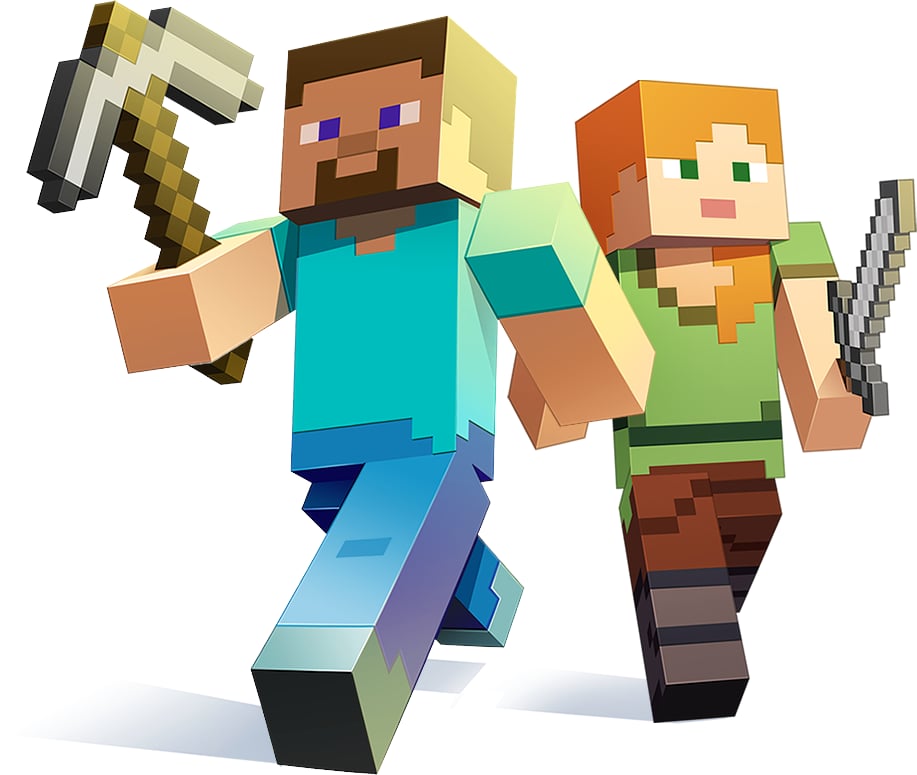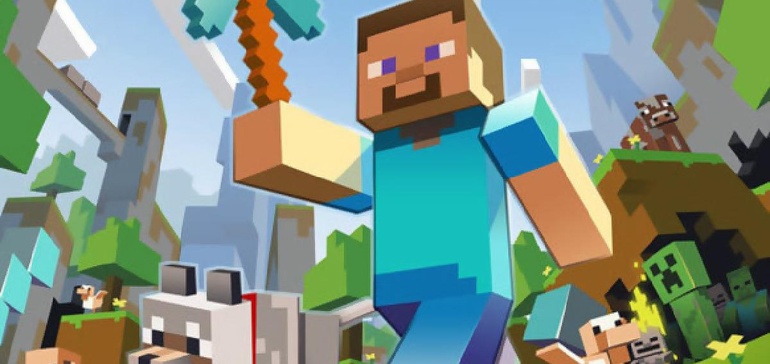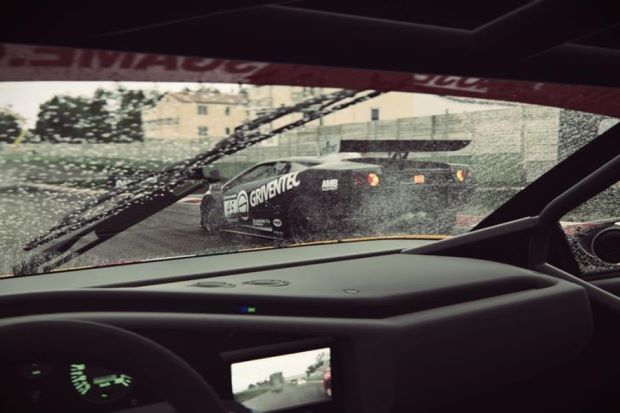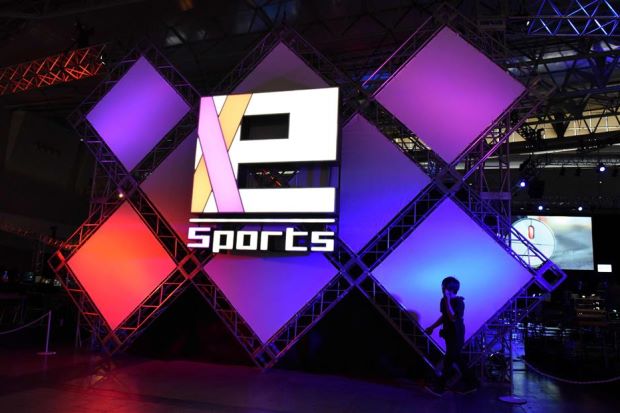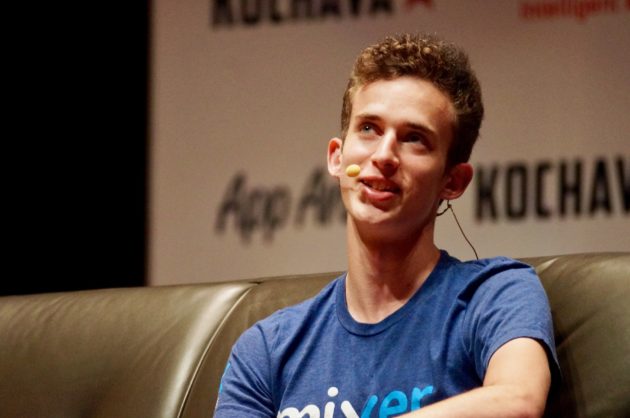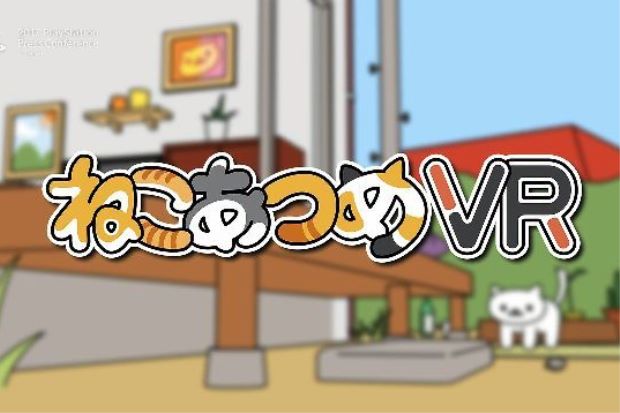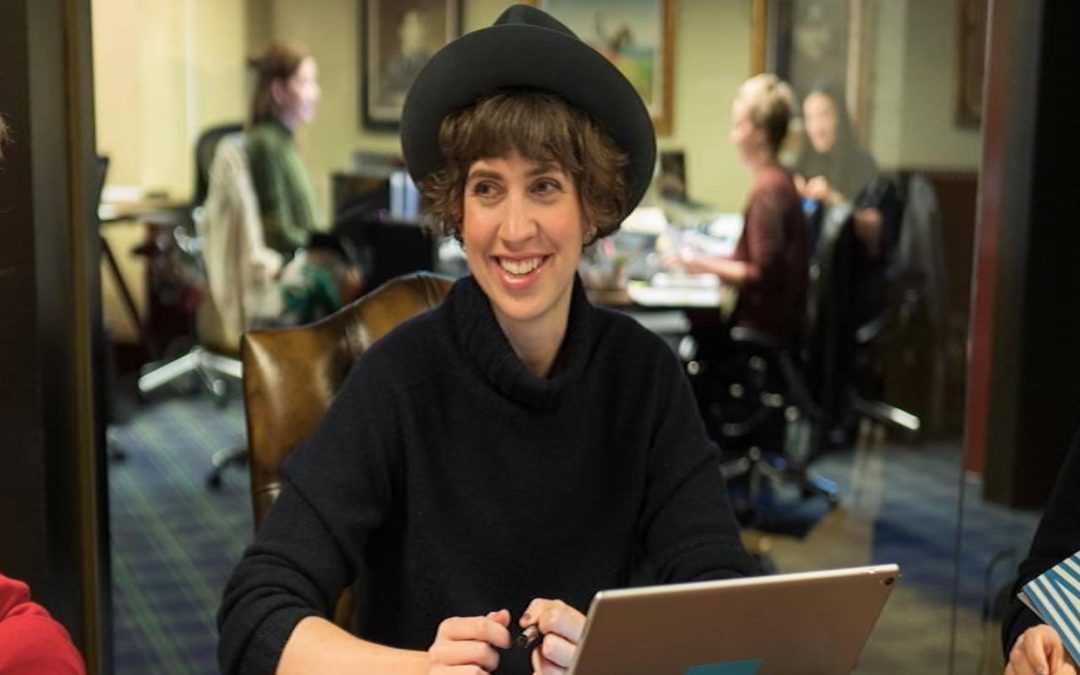
The Incredible True Story of How a Florida Teacher Became Head of 1 of the Biggest Brands on Earth
Lydia Winters is living the dream.
As the brand director at Mojang, she's responsible for maintaining all aspects of the massively popular Minecraft brand — from tiny collectible figurines to international events, Winters has her hands in pretty much everything. It should come as no surprise, then, that her work has landed her on the Forbes 30 Under 30 list, or that she was named one of Sweden's most powerful women in digital in 2016, or that on Nov. 18, she'll be cohosting the company's annual Minecon event with none other than the brilliantly funny Will Arnett. What will come as a surprise is how she got to where she is — and what her job entails on a daily basis.
I interviewed Winters by phone in October, and the first thing she told me — from her office in Stockholm, Sweden — was that she was born in Florida. “I have an elementary education degree, and I taught fourth grade in Florida for a year before I decided that I didn't want to teach anymore — but I didn't really know what I wanted to do,” she said, laughing. “I was just trying to figure it out, I was 21 or 22, and I started doing a lot of photography and shooting weddings, taking portraits of babies and kids.”
It was only after Winters did a photography workshop in 2010 that she was introduced to video blogging, the medium that would eventually land her in her current role. “I was making these really weird daily videos about a lot of random things,” she told me. “In the house that I lived in, I had baby turtles — so one day I'd be singing about baby turtles, and the next day I'd be like ‘I'm sick! I don't know what to talk about!' and the next day I'd be talking about cameras. It was always about different things.”
But despite the initial popularity of her work, Winters knew that she was very much living day to day and didn't have a plan. After successfully raising $10,000 for breast cancer research (and shaving her head, as she promised to do if she hit her goal), she had begun to question the path her life was on once again. “I was like, ‘OK. Now I don't have a job. I just shaved my head. I'm making videos and things appear to have gone terribly wrong. What do I do now?'”
After consulting with friends, she realized that the only way to get her life back on track was to try to do something consistent with her videos, to focus all of her energy on one single topic. Winters decided to focus on video games, but there was one problem: the only video game she'd ever played was Oregon Trail.
“My friends thought it would be hilarious if I played Minecraft from the perspective of someone who doesn't know anything about playing games,” Winters recalled. “This was after I had done this Susan G. Komen 60-mile walk, and someone had given me a hot pink wig. So I was like, ‘OK. I'll wear a pink wig, and I'll call myself — I wanted to be Minecraftgirl, but that username was taken — I'll be Minecraftchick.'”
So, with a pink wig and a second-choice username, Winters began the next stage of her post-teacher life: becoming the lovable woman behind the cult YouTube series The Misadventures of Minecraftchick.
The concept was simple; Winters learned how to play Minecraft in a series of heavily edited shortform videos, interspersed with snarky, self-deprecating commentary. But in a genius twist, Winters chose to film herself as she played, using the video of her facial reactions as an overlay over her gameplay — something that was unheard of in 2010. “Everyone who was doing a very standard, ‘this is my voice, and I am playing right now,'” she said. “I got so much flak for [showing my face]. Now, everyone does it. It's weird if you don't show your face when you're playing, because it's so much more fun to see someone's expression and what they're doing.”
“In the first video, I couldn't even figure out how to walk,” Winters recounted. “I just opened [the game] on my screen, and was like, ‘I am starting this game. I'm so excited!' And then I was clicking everything, and I'm like, ‘How do I move? I'm clicking the mouse, I'm using the arrow keys, and nothing is working.' So I'm like, ‘OK. I'm going to google this. Pause!' and then I come back and say, ‘AH! I figured it out. It's W-A-S-D,' which obviously I didn't know as I had never played games. So of course then I'm like, ‘I can walk! I'm amazing!' and I'm walking and walking and I go into water and I'm like, ‘Wait, which key do I use to swim?' and then, of course, I drown.”
An innovative format may have made her videos stand out, but it was the combination of a severe lack of resources around how it was exactly that one actually was supposed to play Minecraft and her charming, quirky persona that really won YouTube viewers over. Winters says her “black and white commentary” — noting that she was from Florida, and as a result obviously knew how to swim even if her avatar didn't — was what made the videos feel less like a how-to and more like a show. And that show format quickly started gaining followers; in the first week alone, she jumped from 0 to over 2,000 subscribers — and it's then that she decided to up the ante to making daily videos. For five months, she made the videos every single day.
“I was going through a separation at the time,” she said, “and I was like, ‘Oh, man, I really don't know what I want to do. I'm making these videos and it's really fun, but I'm doing a lot of odd jobs on the side – little ad listings and writing for people, or editing or posting stuff – whatever friends had jobs to do, so I can support this pretty hobbyish thing.' But I was gaining tons of subscribers and it was really fun. Every day, my dad would text me and tell me how many new subscribers I had, which was the sweetest thing.”
But in June 2011, Winters again began to question what she was doing. The revelation came while she was living with her ex-husband in her uncle's trailer park house — “the most Florida story I can tell,” she said — and found herself once again struggling to get by. It's then that she came up with the idea of going to video game conference E3 and interviewing the creators of Minecraft for her YouTube channel. She wrote them a cold email that said quite simply, “Hi, I'm Lydia. I'm a serious person. Here's My YouTube channel. I used to be a teacher. If you need any help at E3, I can do whatever. I would just love to interview you for my channel. Super short, whatever you want.”
Carl Manneh, the former CEO of Mojang, wrote back with a much bigger offer: asking her to host the Sony Ericsson Xperia Play Minecraft portion of their booth. Winters questioned whether she was qualified for the role, but with nothing to lose, she dyed her hair pink to match her online persona and flew to LA.
Winters instantly hit it off with the team from Mojang, and she aced the job she had signed up to do. But things took an altogether different turn after she ran into a friend from the internet. The friend had just applied for an art position at Mojang and asked Winters to introduce her to the team — a favor that she obliged — but Manneh informed the friend that the position wasn't in the US and would require a move to Sweden. It's here that Winters did the unexpected.
“Unplanned, I turned around and I said, ‘It's too bad I'm not an artist because I would totally move to Sweden.' And Carl was like, ‘We want someone to work with the community. Let's talk more about this tonight.' And I was like, ‘What?' And I walked away — I remember very vividly being in the LA Convention Center and trying to find some internet because I was thinking, ‘Where is Sweden? I know it's in Europe, but is it in the middle?' But then I googled it and was like, ‘That is SO far north. That is really far north in the world.' But I thought it was all very funny, because obviously it was just a weird conversation and nothing else will come of it.”
Later that evening, Winters attended a mixer — and Manneh essentially told the Mojang team that they were bringing her back to Sweden when they went home. None of the staff could tell if he was serious, but for her part, Winters was over the moon. “I'm texting my mom like, ‘I'm going to move to Sweden, everyone who thought I didn't have a plan.' And she's like, ‘What? No, definitely not.'”
It took until the last day of the event, however, for Winters to finally get a formal interview — and even after all that, she went home to Florida, thinking, “OK, this was all crazy, but they're going to go back to Sweden — they've been swept up in this sort of very American craziness, they're not going to follow through on this because it's crazy and they don't know me. We don't know each other, and this is insane.”
Two weeks after E3 ended, Winters had been hired by Mojang full-time. Six months after accepting the job, she left Florida and started a new life in Stockholm, Sweden. And she's never looked back.
A little over six years later, Winters still loves her job. Her American-ness and penchant toward talking (and talking loudly) made her an enormous asset to the Mojang team, composed mainly of Swedes who prefer, in her words, “next-level quiet.” The role that she took initially saw her looking after the community building related to the Minecraft brand but evolved to become a more senior role looking after all of the merchandising, events, and licensing as well.
“Each thing that has happened in the company has kind of always been like, ‘Well, I can do that,' and you kind of raise your hand and think to yourself, ‘Actually, I don't know if I can,'” she said, laughing. “But six years later I can spot the smallest detail in [something related to] Minecraft that is incorrect and people are like, ‘How did you do that?' And it's because I've looked at it, and I care about it, and I've seen it for so long. So the tiniest thing I can spot in a slide that was two slides ago, like, ‘Hold on. Can you go back a second?'”
There's a reason that Winters has trained herself to spot these sorts of things, and it comes from the best imaginable place: for the love of what she's doing and the people she's doing the work for. “The amazing thing about Minecraft is that it's way more than a game,” she said. “It's a life-changing thing. It's a way to spend time with people; it's a way to communicate. It's so big, and it's so important that every day I'm like, ‘This is too important to screw anything up.' I have to make sure everything is amazing, everything is perfect for this incredible brand that I get to have so much ownership over.”
Every day presents something new and different, and even she herself admits that no two days in a row are ever the same. I asked her to walk me through a typical day at the office, and what became immediately clear is that she really does have her hands in pretty much everything the company does. But naturally, there are some things that are set in stone.
One of those things is her morning routine. “I get up and work out with my personal trainer or at the gym, because I'm on the road to Minecon and I want to look very buff on stage,” she said, laughing. “After that, since I'm a very late person by nature, I'm always on the run from my apartment [to the office], which is on the South Island in Stockholm. My home is a 10-minute walk from work — but I can make it in seven minutes if I run. I'm usually running with a really delicious coffee that my partner has made for me, and I'm kind of spilling it and drinking it as I run into the office.”
On the day I spoke to Winters, she had kicked off her day with a three-hour meeting with one of Mojang's merchandising partners, who pitched a whole host of new ideas for her team to consider. Winters, who said she was “maybe the eighth person hired at the company,” now has a team made up of product designers and project managers who help her with the approval process on each and every piece of merchandise. Her focus is making sure that everything that gets made has an extraspecial touch and “isn't a label slap where the same artwork goes on everything.”
“There's always a reason why something is positioned the way it is,” she said. “There's a reason why a skeleton is being chased by a wolf [on an item] and it's because wolves like bones and that's kind of funny, because it's something that would really happen. A little kid is not going to say, ‘I understand this shirt was very thoughtfully picked for me,' but they may say, ‘Yeah, that is exactly what a skeleton does.' And then there's the adults who buy products, and you want them to go, ‘Wow, there was extra care put into this. This is more special than I thought it would be.'”
It's not just animals and baddies that get a critical look, either. Minecraft used to predominately focus on a guy named Steve, and Winters was instrumental in getting a second main character, a female named Alex, added into the game as well. “I was like, ‘We have all this merchandise and it's only a guy!' and everyone was like, ‘No, Steve is genderless.' And I was like, ‘He has a goatee. He is definitely a guy. He can be whatever gender he wants to be, but his name is Steve. How many Steves do you know that aren't male?'”
Alex has red hair like Jeb, the lead designer, and green eyes like Winters herself — injecting a little bit of the Mojang personality into the game they spend so many hours each day perfecting. But she's also a focal point for many of the conversations that Winters has with her merchandising partners on a day-to-day basis, pointing out the type of relegation that can happen to a female character without a critical eye: “If you're not really careful and vigilant, Alex is always pushed behind Steve. Or she's loving animals, and never doing any of the fighting. They both have to be shown in many different roles, because we have so many different players — on a daily basis, I'm talking about this, and looking at it constantly.”
The conversations that Winters has on a daily basis to avoid gendered typecasting are, in her eyes, crucial to putting forth the best possible version of the game to its users. One example of this is the struggle she went through with a specific brand who didn't understand the importance of equally weighted roles for the “male” and “female” characters.
“There was a description of Steve and a description of Alex,” Winters said. “In the description of Steve, he was an architect, a designer, or a geologist or something. For Alex, it said, ‘She likes to build, explore, and mine.' The two were sitting next to each other, and I was like, ‘Look at the difference between these two descriptions. You are saying that because Steve is male he has a job — Steve's not an architect, he's just a dude that builds. But if you're going to say he has a job, at least use the same language for both of them. Either they both have jobs or they both like to do certain things.'”
Over the years, Winters has seen countless examples of Alex being mentioned with regard to fashion and Steve in relation to great careers and always puts the kibosh on it immediately. “You know that this will never go through,” she has told numerous clients, adding, “This isn't OK. There's no world in which we will approve this. Rewrite it. This not gender equal.”
The statement applies not just to descriptions of the two characters, but their positioning, the weapons they use, and the real-life models that are used to show off the goods that the company signs off on. In her mind, both characters should be portrayed as badasses — not one over the other. “I've had pink hair, I love pink, I love purple, I love animals,” she explained. “That's fine, but there are also girls who don't love any of that.”
It's clear in looking at Mojang's myriad offerings that these “soapbox moments from Lydia” have made a tangible difference — and an unexpected extra benefit is that it has also affected the workplace culture of Mojang as well. Winters, who once saw herself as a lone wolf hopping around doing whatever needed to be done, now has five people reporting into her and a whole lot more women standing by her side when she has these conversations.
“I was the first woman in the office, and then there were two of us — our CFO and I — and now, I'm happy to say, we have a huge amount of women working in the office,” Winters said, noting that she spent her lunch hour after the merchandising meeting doing a one-on-one with one of her direct reports. “They're all amazing and incredible and save me so much time and have so many amazing ideas — and I'm transitioning into a better leader and a better boss because I take it very seriously, making sure that they're developing as much as possible, just like I'm trying to.”
But she's not just a manager and a brand champion. She's also a brand ambassador, so Winters spent the afternoon before we got on the phone planning out the big reveal for this year's annual Minecon: that she'll be joined on stage with Will Arnett.
“It's both the most exciting thing and the most panic-inducing thing I've ever done, because it's like, whoa, this is the big leagues now – I'm going to be on stage with Will. And I think he's amazing and I have for so long that I'm like, oh my god I'm going to pass out. And it will be so bad if I just faint,” she said, noting that while she may be fangirling out now, the most exciting part of him hosting is that he's a huge fan of Minecraft himself.
“He was super interested in cohosting Minecon because he and his kids play together. And we always care about someone having a personal connection to Minecraft. I want everyone to play, but I get that it's not for every single person — and there's something really special about finding someone who's not just awesome at what they do but they also like Minecraft, too.”
The rest of the hours of her workday are spent scripting and shooting the video Mojang will release to the public the following day. Minecon planning takes up a big chunk of the year — involving meticulous strategizing, researching, and surprising — and as a result her day-to-day workload is some combination of scripting, shooting, and merchandising. But that's on top of the mentoring and managing she does, and the work she undertakes as part of Mojang's leadership team. In short: it's damn near impossible to sum up everything Winters does.
Even so, the excitement and energy that Winters brings to her job is palpable in everything she does — and it's clear that she's come a long way from her days in Florida, wondering what would happen next. Winters is now an inspiration to millions of women and girls around the world and proof that anything is possible so long as you put your full heart and mind into it and aren't afraid of what might happen if you fail.
“I have yet to have a day where I've felt bored in over six years,” she told me, humbly. “So I feel like something I'm doing is right.”
The Incredible True Story of How a Florida Teacher Became Head of 1 of the Biggest Brands on Earth

